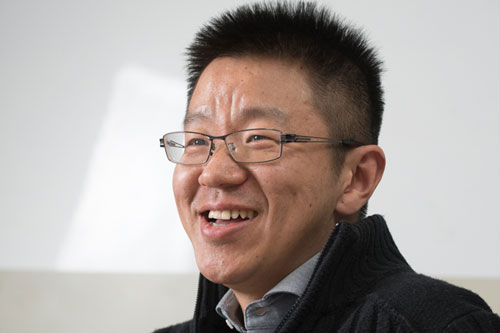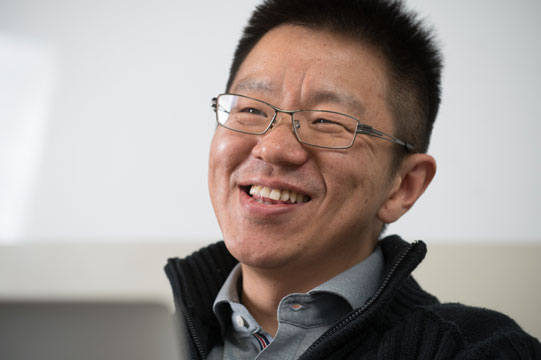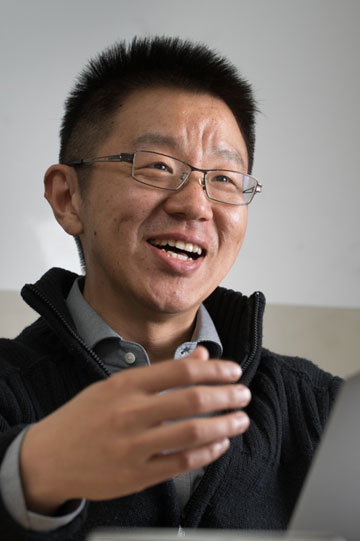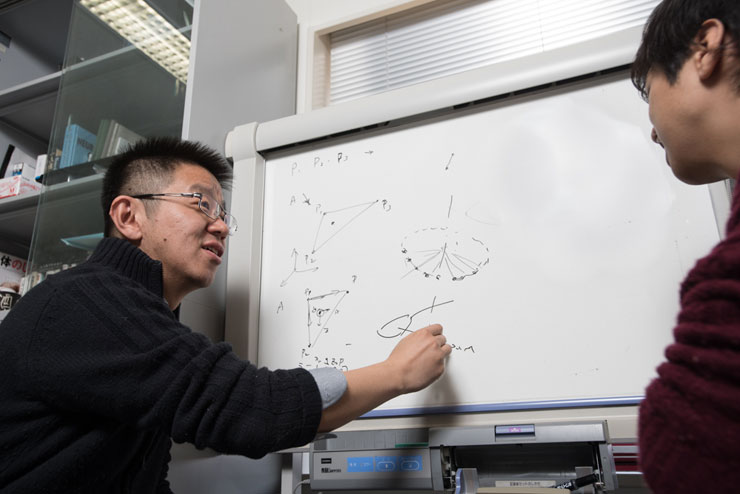
Ming DING
Assistant ProfessorNara Institute of Science and Technology
Interview : March 12, 2018
Attractive Environment that Allows Constant Pursuit of the New World
 He was already writing computer programs using BASIC when he was six or seven years old. By imitating what his older brother (5 years his senior) was doing, he created something like an address book that retrieves and indicates personal information when searched by name. "I did not enjoy school subjects that required a lot of memory work, but I was strong in math and science, where I could make progress through logical connections once I'd learned the rules." Since he got involved in university education as an assistant professor, he has been trying to figure out the students' favorite subjects and interests so that he can link them with their research work because "You need to work on your favorite thing to keep you motivated."
He was already writing computer programs using BASIC when he was six or seven years old. By imitating what his older brother (5 years his senior) was doing, he created something like an address book that retrieves and indicates personal information when searched by name. "I did not enjoy school subjects that required a lot of memory work, but I was strong in math and science, where I could make progress through logical connections once I'd learned the rules." Since he got involved in university education as an assistant professor, he has been trying to figure out the students' favorite subjects and interests so that he can link them with their research work because "You need to work on your favorite thing to keep you motivated."
Research is a Fascinating Career that Allows for Learning About Cutting-Edge Subjects at Will
After studying mechanical engineering at a university in China, he worked seriously on robotics studies in Japan. He went on to Nara Institute of Science and Technology (NAIST) and was fascinated by the intellect of his seniors in the laboratory there.
"There were senior PhDs who could do various things such as creating computer graphics or a web page and designing a machine for themselves."
 He says his fascination with a research career comes from the fact that he can keep learning about cutting-edge subjects by always using his interests as antennas.
He says his fascination with a research career comes from the fact that he can keep learning about cutting-edge subjects by always using his interests as antennas.
At NAIST, he worked on pinpointing and building up only specific muscles using a power assist device. He says he allowed his mind to concentrate on that research so much that he neglected his health and put on weight during that period. "I'm afraid I won't be persuasive if I present my research findings about muscles when I am so flabby. So, since then, I've been taking care to run around the campus and build up my body."
He has been a visiting researcher at Carnegie Mellon University (CMU) in the United States since 2017. A small seminar at CMU has a liberal atmosphere where undergraduate students eat, drink, and ask questions without any hesitation while a renowned researcher is giving a presentation. "Graduate students in Japan call their mentor Professor so-and-so, whereas the graduate students at CMU say ‘I am working with so-and-so.’ I noticed the difference in attitude toward research work and the degree of autonomy."
Searching for “Good Relations” Between Robots and Human Beings
At CMU, he is studying the ability of computers to judge resemblances in movement between two people. "Movements can all differ depending on whether the person is a man or a woman, young or elderly. Animation creators have such movement characteristics in their minds. Using their knowledge for reference, I would like to determine a computer measurement for the degree of resemblances and differences in movement."
This technique can also be applied in the medical field, where an experienced physician's insight into a patient's latent disease, usually gleaned only by looking at his or her gait, can be computerized. The technique can be used to assess the training results of elderly people or athletes.
In the future, he would like to delve further into the mutual relationships between humans and robots. "What sort of robots' help can make people feel happy and comfortable? How can we gather human reactions and make robots understand them? I would like to collaborate with researchers from various fields." This is the cutting-edge field where he can take advantage of his research experiences in China, Japan, and the United States and the large network of researchers and other acquaintances he has gained there.

 Home
Home